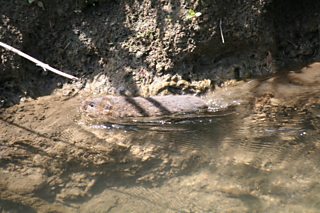Water voles: why this endearing, yet endangered species needs our help
Emily Thomas
Emily Thomas, Key Species Monitoring and Data Officer, PTES
The natural world has always fascinated me; from an early age I loved going for walks in the countryside or our local park to watch wildlife, typically birds as they are usually the most visible: red kites in rural Wales, green woodpeckers and kestrels in London, and skylarks on the South Downs. However, my real passion has always been reserved for our more elusive and inconspicuous mammals. This love led me to study the urban foxes of Bristol for my undergrad dissertation, to Poland for two months radio-tracking European bison and stone martens and to work on a project developing footprint tracking tunnels to detect hedgehogs during my Masters degree.
I started working for People’s Trust for Endangered Species (PTES) in 2013 just after completing my Masters. I was initially involved in our Hedgehog Street campaign but then in 2014 I was offered the chance to set up and launch a new National Water Vole Monitoring Programme and a new species entered my life. I had a basic knowledge of water voles and their plight from my studies so I leapt at the chance to set something up that would help the conservation of this much love species, immortalised as Ratty in Kenneth Grahame’s The Wind in the Willows.

Water vole burrows
Water voles are incredibly endearing to look at; about the size of a small guinea pig, with a rounded body, blunt nose and small ears hidden in thick fur. They have to eat 80% of their body weight every day, so if you are lucky enough to spot one, they are usually in the process of tucking into one of the 227 species of plant that makes up their diet! However, water voles themselves are on the menu for many different species (foxes, pike, herons, owls and stoats, to name a few), making them understandably rather flighty, so often the only way you will know there is one near you is a ‘plop’ as they flee into the water.
Once a common sight along UK waterways, water voles have experienced the most serious decline of any British wild mammal over the last century. This shocking drop in their numbers is due in part to habitat loss and destruction along many of our waterways. But the critical threat comes from, predation by non-native American mink. The impact of mink has been particularly devastating: national surveys conducted by The Vincent Wildlife Trust between 1989-1998 found the water vole population crashed by nearly 90% in that period alone. Since the 1990s conservation groups have been working hard to improve habitats and control mink numbers to try and save the much loved water vole but it’s important to monitor how populations have responded and what the current national picture is.
That’s why in 2015, PTES launched the first ongoing National Water Vole Monitoring Programme (NWVMP) across England, Scotland and Wales. The randomly selected sites that were visited during the two previous surveys form the basis of the NWVMP. By regularly resurveying these sites, we hope to be able to detect any changes that have occurred since 1998, as well as detect any future changes. We’ve had a fantastic response to the NWVMP from the public over the last two years and the data collected so far is invaluable…but we still need more sites to be surveyed annually to ensure all regions have sufficient data being collected.
As with many mammals it is not always possible to see water voles, even if they are present. Therefore, the best way to check if they’re present is to keep an eye out for the signs they have left behind: droppings, feeding remains and burrows.
Latrines
Water voles mark out their territories using piles of droppings, known as latrines, and these are the most distinctive and reliable sign that they are in residence. Droppings are cylindrical with blunt ends, usually 12mm long and 4-5mm wide, resembling a large ‘tic tac’. The colour varies depending on the diet, ranging from green through to dark purple/black.
Feeding remains
Feeding remains are often neat piles of chewed lengths of vegetation that are discarded after they have nibbled off the best parts. Lengths of vegetation are typically 8cm long and have 45 degree cuts to their ends.
Burrows
Water voles dig networks of burrows along the water’s edge, using their teeth, rather than their paws. Some are just above or at the water level on steep banks, others can be below the water level, ensuring the water vole has a number of escape routes available.

A young water vole swimming
These field signs form the basis of the monitoring programme survey. We are asking volunteers to select a site to monitor, and then visit their site each May and search a 500m stretch of riverbank for any signs and sightings and then report back to us. Volunteers can either select to monitor one the pre-selected sites, or they can register their own site with the monitoring programme. To find out more about taking part and to register to take part please visit
Over the last few years I’ve been lucky enough to see water voles on a number of occasions and the thrill of seeing them, or even just the evidence that they are around, never dims. Let’s hope that their numbers are able to recover and they once again become a common sight across the UK for everyone to enjoy.
The 主播大秀 is not responsible for the content of external sites.
